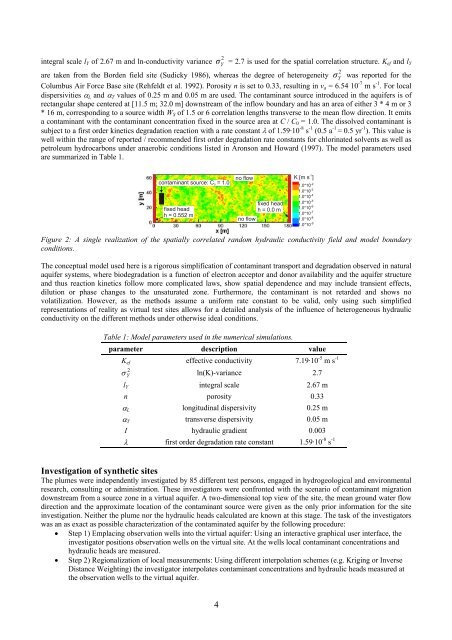Applied numerical modeling of saturated / unsaturated flow and ...
Applied numerical modeling of saturated / unsaturated flow and ...
Applied numerical modeling of saturated / unsaturated flow and ...
You also want an ePaper? Increase the reach of your titles
YUMPU automatically turns print PDFs into web optimized ePapers that Google loves.
2<br />
integral scale lY <strong>of</strong> 2.67 m <strong>and</strong> ln-conductivity variance σ Y = 2.7 is used for the spatial correlation structure. Kef <strong>and</strong> lY<br />
2<br />
are taken from the Borden field site (Sudicky 1986), whereas the degree <strong>of</strong> heterogeneity σ Y was reported for the<br />
Columbus Air Force Base site (Rehfeldt et al. 1992). Porosity n is set to 0.33, resulting in va = 6.54 10 -7 m s -1 . For local<br />
dispersivities αL <strong>and</strong> αT values <strong>of</strong> 0.25 m <strong>and</strong> 0.05 m are used. The contaminant source introduced in the aquifers is <strong>of</strong><br />
rectangular shape centered at [11.5 m; 32.0 m] downstream <strong>of</strong> the in<strong>flow</strong> boundary <strong>and</strong> has an area <strong>of</strong> either 3 * 4 m or 3<br />
* 16 m, corresponding to a source width WS <strong>of</strong> 1.5 or 6 correlation lengths transverse to the mean <strong>flow</strong> direction. It emits<br />
a contaminant with the contaminant concentration fixed in the source area at C / C0 = 1.0. The dissolved contaminant is<br />
subject to a first order kinetics degradation reaction with a rate constant λ <strong>of</strong> 1.59·10 -8 s -1 (0.5 a -1 = 0.5 yr -1 ). This value is<br />
well within the range <strong>of</strong> reported / recommended first order degradation rate constants for chlorinated solvents as well as<br />
petroleum hydrocarbons under anaerobic conditions listed in Aronson <strong>and</strong> Howard (1997). The model parameters used<br />
are summarized in Table 1.<br />
contaminant source: C = 1.0<br />
0<br />
fixed head<br />
h = 0.552 m<br />
4<br />
no <strong>flow</strong><br />
no <strong>flow</strong><br />
fixed head<br />
h = 0.0 m<br />
-1<br />
K [m s ]<br />
Figure 2: A single realization <strong>of</strong> the spatially correlated r<strong>and</strong>om hydraulic conductivity field <strong>and</strong> model boundary<br />
conditions.<br />
The conceptual model used here is a rigorous simplification <strong>of</strong> contaminant transport <strong>and</strong> degradation observed in natural<br />
aquifer systems, where biodegradation is a function <strong>of</strong> electron acceptor <strong>and</strong> donor availability <strong>and</strong> the aquifer structure<br />
<strong>and</strong> thus reaction kinetics follow more complicated laws, show spatial dependence <strong>and</strong> may include transient effects,<br />
dilution or phase changes to the un<strong>saturated</strong> zone. Furthermore, the contaminant is not retarded <strong>and</strong> shows no<br />
volatilization. However, as the methods assume a uniform rate constant to be valid, only using such simplified<br />
representations <strong>of</strong> reality as virtual test sites allows for a detailed analysis <strong>of</strong> the influence <strong>of</strong> heterogeneous hydraulic<br />
conductivity on the different methods under otherwise ideal conditions.<br />
1.0*10 -2<br />
1.0*10 -3<br />
1.0*10 -4<br />
1.0*10 -5<br />
1.0*10 -6<br />
1.0*10 -7<br />
1.0*10 -8<br />
1.0*10 -9<br />
Table 1: Model parameters used in the <strong>numerical</strong> simulations.<br />
parameter description value<br />
Kef effective conductivity 7.19·10 -5 m s -1<br />
2<br />
σ Y<br />
ln(K)-variance 2.7<br />
lY integral scale 2.67 m<br />
n porosity 0.33<br />
αL longitudinal dispersivity 0.25 m<br />
αT transverse dispersivity 0.05 m<br />
I hydraulic gradient 0.003<br />
λ first order degradation rate constant 1.59·10 -8 s -1<br />
Investigation <strong>of</strong> synthetic sites<br />
The plumes were independently investigated by 85 different test persons, engaged in hydrogeological <strong>and</strong> environmental<br />
research, consulting or administration. These investigators were confronted with the scenario <strong>of</strong> contaminant migration<br />
downstream from a source zone in a virtual aquifer. A two-dimensional top view <strong>of</strong> the site, the mean ground water <strong>flow</strong><br />
direction <strong>and</strong> the approximate location <strong>of</strong> the contaminant source were given as the only prior information for the site<br />
investigation. Neither the plume nor the hydraulic heads calculated are known at this stage. The task <strong>of</strong> the investigators<br />
was an as exact as possible characterization <strong>of</strong> the contaminated aquifer by the following procedure:<br />
• Step 1) Emplacing observation wells into the virtual aquifer: Using an interactive graphical user interface, the<br />
investigator positions observation wells on the virtual site. At the wells local contaminant concentrations <strong>and</strong><br />
hydraulic heads are measured.<br />
• Step 2) Regionalization <strong>of</strong> local measurements: Using different interpolation schemes (e.g. Kriging or Inverse<br />
Distance Weighting) the investigator interpolates contaminant concentrations <strong>and</strong> hydraulic heads measured at<br />
the observation wells to the virtual aquifer.

















